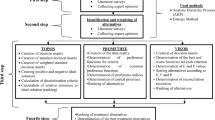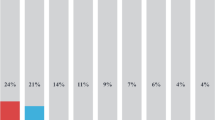Abstract
This study aims to evaluate the extraction methods of rare earth elements (REEs) from aqueous solution streams using the analytic hierarchy process (AHP) method. However, their extraction from aqueous solutions is challenging due to their low concentration and complex chemical properties. The AHP method is a multi-criteria decision-making tool that allows for the prioritization of different criteria based on their relative importance. In this study, eight extraction methods were evaluated based on three criteria: economic justification, technical justification, and environmental justification. The eight methods included adsorption, biosorption, chemical precipitation, electrocoagulation, ion flotation, ion exchange, membrane filtration, and solvent extraction. The results showed that flotation was the most efficient method for REE extraction, with a score of 0.176, followed by adsorption, with a score of 0.149. Biosorption and solvent extraction had lower scores of 0.147 and 0.136, respectively. Besides, another AHP was conducted to prioritize the three surfactant categories used in the ion flotation process based on seven criteria: capacity, cost, efficiency, recovery duration, repeatability, scalability, and selectivity. The three surfactant categories included bio-based, chemo-based, and nano-based surfactants. The results indicate that nano-surfactants were the most suitable surfactants for REE extraction by ion flotation with a score of 0.465, followed by chemo-surfactants with a score of 0.390. Overall, this study provides valuable insights into evaluating different REE extraction methods using the AHP methodology. The findings can help researchers and industry professionals decide on selecting appropriate REE extraction methods based on their specific needs and priorities.
Graphical abstract





Similar content being viewed by others
Abbreviations
- AHP:
-
Analytic hierarchy process
- AMD:
-
Acid mine drainage
- CFAL:
-
Coal fly ash leachate
- CI:
-
Consistency index
- CR:
-
Consistency ratio
- CRMs:
-
Critical raw materials
- EU:
-
European union
- Eu:
-
Europium
- E-waste:
-
Electronic-waste
- GB:
-
Geothermal brines
- LREEs:
-
Light rare earth elements
- Lu:
-
Lutecium
- MSWI:
-
Municipal solid waste incineration
- REEs:
-
Rare earth elements
- RI:
-
Reliability indicators
- Sc:
-
Scandium
- Sm:
-
Samarium
- SW:
-
Seawater
- Y:
-
Yttrium
References
Ahmad K, Nazir MA, Qureshi AK, Hussain E, Najam T, Javed MS, Shah SSA, Tufail MK, Hussain S, Khan NA (2020) Engineering of Zirconium based metal-organic frameworks (Zr-MOFs) as efficient adsorbents. Mater Sci Eng B 262:114766
Ahmad K, Ashfaq M, Shah SSA, Hussain E, Naseem HA, Parveen S, Ayub A (2021) Effect of metal atom in zeolitic imidazolate frameworks (ZIF-8 and 67) for removal of Pb2+ and Hg2+ from water. Food Chem Toxicol 149:112008
Alemrajabi M, Ricknell J, Samak S, Rodriguez Varela R, Martinez J, Hedman F, Forsberg K, Rasmuson ÅC (2022) Separation of rare-earth elements using supported liquid membrane extraction in pilot scale. Ind Eng Chem Res
Alipour S, Sadeghi A, Omidvarborna H, Karimi A (2022a) Techno-economic assessment of the AHP based selected method for separating formic acid from an aqueous effluent. J Chem Petrol Eng 56(1):105–121
Alipour S, Sagir E, Sadeghi A (2022b) Multi-criteria decision-making approach assisting to select materials for low-temperature solid oxide fuel cell: electrolyte, cathode& anode. Int J Hydrog Energy 47(45):19810–19820
Anastopoulos I, Bhatnagar A, Lima EC (2016) Adsorption of rare earth metals: a review of recent literature. J Mol Liq 221:954–962
Asadollahzadeh M, Torkaman R, Torab-Mostaedi M (2021) Extraction and separation of rare earth elements by adsorption approaches: current status and future trends. Sep Purif Rev 50(4):417–444
Astuti Y, Andianingrum R, Arnelli Haris A, Darmawan A (2020) The role of H2C2O4 and Na2CO3 as precipitating agents on the physichochemical properties and photocatalytic activity of bismuth oxide. Open Chem 18(1):129–137
Brahim JA, Hak SA, Achiou B, Boulif R, Beniazza R, Benhida R (2022) Kinetics and mechanisms of leaching of rare earth elements from secondary resources. Miner Eng 177:107351
Can Sener SE, Thomas VM, Hogan DE, Maier RM, Carbajales-Dale M, Barton MD, Karanfil T, Crittenden JC, Amy GL (2021) Recovery of critical metals from aqueous sources. ACS Sustain Chem Eng 9(35):11616–11634
Cao W, Wang A, Yu D, Liu S, Hou W (2019) Establishment and implementation of an asphalt pavement recycling decision system based on the analytic hierarchy process. Resour Conserv Recycl 149:738–749
Cao Y, Shao P, Chen Y, Zhou X, Yang L, Shi H, Yu K, Luo X, Luo X (2021) A critical review of the recovery of rare earth elements from wastewater by algae for resources recycling technologies. Resour Conserv Recycl 169:105519
Chang L, Cao Y, Fan G, Li C, Peng W (2019) A review of the applications of ion floatation: wastewater treatment, mineral beneficiation and hydrometallurgy. RSC Adv 9(35):20226–20239
Chen Z, Li Z, Chen J, Kallem P, Banat F, Qiu H (2022) Recent advances in selective separation technologies of rare earth elements: a review. J Environ Chem Eng 10(1):107104
Dardona M, Mohanty SK, Allen MJ, Dittrich TM (2023) From ash to oxides: recovery of rare-earth elements as a step towards valorization of coal fly ash waste. Sep Purif Technol 314:123532
Dashti S, Sadri F, Shakibania S, Rashchi F, Ghahreman A (2021) Separation and solvent extraction of rare earth elements (Pr, Nd, Sm, Eu, Tb, and Er) using TBP and Cyanex 572 from a chloride medium. Miner Eng 161:106694
de Vasconcellos ME, Da Rocha S, Pedreira W, Queiroz CA, d. S., & Abrão, A. (2008) Solubility behavior of rare earths with ammonium carbonate and ammonium carbonate plus ammonium hydroxide: precipitation of their peroxicarbonates. J Alloy Compd 451(1–2):426–428
Deblonde GJ-P, Mattocks JA, Park DM, Reed DW, Cotruvo JA Jr, Jiao Y (2020) Selective and efficient biomacromolecular extraction of rare-earth elements using lanmodulin. Inorg Chem 59(17):11855–11867
Dinh T, Dobo Z, Kovacs H (2022) Phytomining of rare earth elements–a review. Chemosphere 297:134259
El Ouardi Y, Virolainen S, Mouele ESM, Laatikainen M, Repo E, Laatikainen K (2023) The recent progress of ion exchange for the separation of rare earths from secondary resources–a review. Hydrometallurgy 218:106047
Elbashier E, Mussa A, Hafiz M, Hawari AH (2021) Recovery of rare earth elements from waste streams using membrane processes: an overview. Hydrometallurgy 204:105706
Fallatah AM, Shah HUR, Ahmad K, Ashfaq M, Rauf A, Muneer M, Ibrahim MM, El-Bahy ZM, Shahzad A, Babras A (2022) Rational synthesis and characterization of highly water stable MOF@ GO composite for efficient removal of mercury (Hg2+) from water. Heliyon 8(10):e10936
İnan S, Tel H, Sert Ş, Çetinkaya B, Sengül S, Özkan B, Altaş Y (2018) Extraction and separation studies of rare earth elements using Cyanex 272 impregnated Amberlite XAD-7 resin. Hydrometallurgy 181:156–163
Karimi A, Sadeghi A (2022) AHP-Based amine selection in sour gas treating process: simulation and optimization. Iranian J Chem Chem Eng (IJCCE)
Li D (2019) Development course of separating rare earths with acid phosphorus extractants: a critical review. J Rare Earths 37(5):468–486
Liu J, Martin PF, McGrail BP (2021) Rare-earth element extraction from geothermal brine using magnetic core-shell nanoparticles-techno-economic analysis. Geothermics 89:101938
Masry B, Abu Elgoud E, Riz S (2023) Correction: Modeling and equilibrium studies on the recovery of praseodymium (III), dysprosium (III) and yttrium (III) using acidic cation exchange resin. BMC Chemistry 17(1):41
Mwewa B, Tadie M, Ndlovu S, Simate GS, Matinde E (2022) Recovery of rare earth elements from acid mine drainage: a review of the extraction methods. J Environ Chem Eng 10:107704
Najam T, Ahmad Khan N, Ahmad Shah SS, Ahmad K, Sufyan Javed M, Suleman S, Sohail Bashir M, Hasnat MA, Rahman MM (2022) Metal-organic frameworks derived electrocatalysts for oxygen and carbon dioxide reduction reaction. Chem Rec 22(7):e202100329
Nawab A, Yang X, Honaker R (2022) Parametric study and speciation analysis of rare earth precipitation using oxalic acid in a chloride solution system. Miner Eng 176:107352
Opare EO, Struhs E, Mirkouei A (2021) A comparative state-of-technology review and future directions for rare earth element separation. Renew Sustain Energy Rev 143:110917
Page MJ, Soldenhoff K, Ogden MD (2017) Comparative study of the application of chelating resins for rare earth recovery. Hydrometallurgy 169:275–281
Parveen S, Naseem HA, Ahmad K, Shah H-U-R, Aziz T, Ashfaq M, Rauf A (2023) Design, synthesis and spectroscopic characterizations of medicinal hydrazide derivatives and metal complexes of malonic ester. Curr Bioact Compd 19(4):31–46
Peng W, Chang L, Li P, Han G, Huang Y, Cao Y (2019) An overview on the surfactants used in ion flotation. J Mol Liq 286:110955
Pereao O, Bode-Aluko C, Fatoba O, Laatikainen K, Petrik L (2018) Rare earth elements removal techniques from water/wastewater: a review. Desalin Water Treat 130:71–86
Perez JPH, Folens K, Leus K, Vanhaecke F, Van Der Voort P, Du Laing G (2019) Progress in hydrometallurgical technologies to recover critical raw materials and precious metals from low-concentrated streams. Resour Conserv Recycl 142:177–188
Quijada-Maldonado E, Romero J (2021) Solvent extraction of rare-earth elements with ionic liquids: toward a selective and sustainable extraction of these valuable elements. Curr Opin Green Sustain Chem 27:100428
Salman A, Juzsakova T, Jalhoom M, Ibrahim R, Domokos E, Al-Mayyahi M, Abdullah T, Szabolcs B, Al-Nuzal S (2022) Studying the extraction of scandium (III) by macrocyclic compounds from aqueous solution using optimization technique. Int J Environ Sci Technol 19(11):11069–11086
Smith YR, Kumar P, McLennan JD (2017) On the extraction of rare earth elements from geothermal brines. Resources 6(3):39
Soukeur A, Szymczyk A, Berbar Y, Amara M (2021) Extraction of rare earth elements from waste products of phosphate industry. Sep Purif Technol 256:117857
Tunsu C, Menard Y, Eriksen DØ, Ekberg C, Petranikova M (2019) Recovery of critical materials from mine tailings: a comparative study of the solvent extraction of rare earths using acidic, solvating and mixed extractant systems. J Clean Prod 218:425–437
Vargas SJ, Quintao JC, Ferreira GM, Da Silva LH, Hespanhol MC (2019) Lanthanum and cerium separation using an aqueous two-phase system with ionic liquid. J Chem Eng Data 64(10):4239–4246
Wu S, Wang L, Zhang P, El-Shall H, Moudgil B, Huang X, Zhao L, Zhang L, Feng Z (2018) Simultaneous recovery of rare earths and uranium from wet process phosphoric acid using solvent extraction with D2EHPA. Hydrometallurgy 175:109–116
Xu C, Tang T, Jia H, Xu M, Xu T, Liu Z, Long Y, Zhang R (2019) Benefits of coupled green and grey infrastructure systems: evidence based on analytic hierarchy process and life cycle costing. Resour Conserv Recycl 151:104478
Zhang L, Lavagnolo MC, Bai H, Pivato A, Raga R, Yue D (2019) Environmental and economic assessment of leachate concentrate treatment technologies using analytic hierarchy process. Resour Conserv Recycl 141:474–480
Zhao F, Repo E, Meng Y, Wang X, Yin D, Sillanpää M (2016) An EDTA-β-cyclodextrin material for the adsorption of rare earth elements and its application in preconcentration of rare earth elements in seawater. J Colloid Interface Sci 465:215–224
Acknowledgements
The authors would like to thank Dr. Karimi and Dr. Alipour for their invaluable comments. Their expertise and insights have been instrumental in shaping this paper.
Funding
The authors declare the following financial interests/personal relationships which may be considered as potential.
Author information
Authors and Affiliations
Corresponding author
Ethics declarations
Conflict of interests
The authors declare that they have no known competing financial interests or personal relationships that could have appeared to influence the work reported in this paper.
Additional information
Editorial responsibility: Binbin Huang.
Rights and permissions
Springer Nature or its licensor (e.g. a society or other partner) holds exclusive rights to this article under a publishing agreement with the author(s) or other rightsholder(s); author self-archiving of the accepted manuscript version of this article is solely governed by the terms of such publishing agreement and applicable law.
About this article
Cite this article
Sadeghi, A., Kermani Alghorayshi, S.T., Shamsi, M. et al. Multi-criteria evaluation of the extraction methods of rare earth elements from aqueous streams. Int. J. Environ. Sci. Technol. 20, 9707–9716 (2023). https://doi.org/10.1007/s13762-023-05081-7
Received:
Revised:
Accepted:
Published:
Issue Date:
DOI: https://doi.org/10.1007/s13762-023-05081-7




